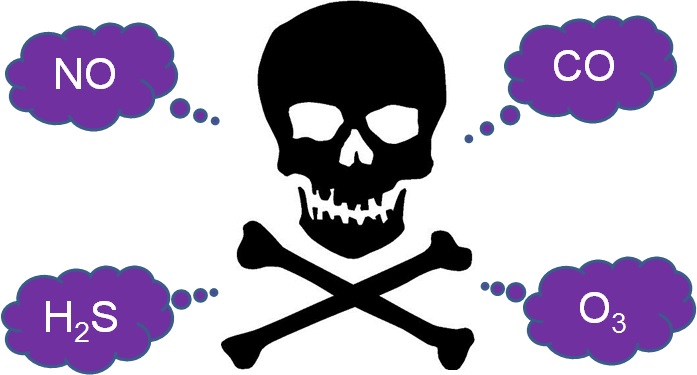What do you imagine when you hear the word “poison gases”? I suppose you thought about things such as chemical weapons and volcanic gases, which are dangerous and are substances that you would rather avoid. Nevertheless, has it occurred to you that “poison gases” actually exist inside your body?
-
Nitrogen Monoxide
Nitrogen monoxide (NO) is present in car exhausts and is considered as an air pollutant causing photochemical smog and acid rain.
On the other hand, nitrogen monoxide is biosynthesised in the body by the nitric oxide synthase (NOS) enzyme from the amino acid, L-arginine, and is known to play important roles in living organisms such as sterilisation, vasodilation, and signal transduction.
Nitroglycerine, which is known to be an explosive, actually acts as an antianginal drug through increasing the NO production in the blood.
-
Carbon Monoxide
Carbon monoxide binds strongly to haemoglobin more tightly than oxygen does, thus inhibiting oxygen uptake and causes poisoning in humans. They are generated by incomplete combustion, for example in heating equipment. Due to their colourless and odourless nature, carbon monoxide is difficult to detect, and therefore ventilation is required when using gas stoves and heating appliances during the winter. Despite the dangers associated with it, carbon monoxide is also generated in the body.

Figure. Decomposition of haemoglobin and generation of carbon monoxide: Haemoglobin → Biliverdin + Fe3+ + CO
Haemoglobin, which is the target of carbon monoxide, generates CO from decomposition by the enzyme, heme oxygenase. CO has been reported to facilitate vasodilation by detecting low oxygen levels[1] and their physiological role is gradually being elucidated.
-
Ozone
The first thing that may come up to your mind when you hear the word ozone may be the ozone layer. This layer is present high up in the stratosphere and it absorbs harmful ultra-violet (UV) light, thus reducing the amount of UV light that reaches the ground. Although ozone is essential to support life on earth, this gas is toxic towards humans due to its strong oxidising ability. This ozone is also produced in the body .[2]
Singlet oxygen is generated from the enzyme, myeloperoxidase (MPO) of microphages. This is then converted to ozone from catalysis of the IgG antibody. Arising from its oxidising ability, ozone is considered to sterilise pathogens that enter the body.
Hydrogen sulfide is known as a volcanic gas and is the source of the smell of rotten eggs. Its strong odour, irritability towards the mucous membrane, and acute intoxication from inhibition of cytochrome C oxidase enzyme in mitochondria, makes hydrogen sulfide a dangerous gas. Again, this gas is also produced within our bodies.

Figure. Biosynthesis of hydrogen sulfide (Excerpt from press release (Japanese) of National Center of Neurology and Psychiatry (NCNP)
Hydrogen sulfide is synthesised in the body from numerous routes involving the amino acid, L-cysteine and cystathionine β-synthase (CBS) enzyme. Hydrogen sulfide has been reported to protect tissues from oxidative stress and is considered to be deeply involved in the defense towards oxidative stress in organisms.
Recent studies have reported the D-amino acid oxidase (DAO) route based on D-cysteine to generate hydrogen sulfide.[3] This substance is expected to act as a new drug towards the treatment of ischemia-reperfusion injury in kidneys.
- Future of Biogenic Gas Molecules
The role of low molecular weight gas molecules in living organisms is gradually being revealed through advances in analytical techniques (link). Recent studies are focusing on the use of these gas molecules in medical treatments. There may be a day where gases that were once considered as poisons may be used as medicines.
This post is an English translation of the original blog post written in Japanese. The original post can be found here.
-
Related Links
National Center of Neurology and Psychiatry (NCNP)
-
References
[1] Hypoxic regulation of the cerebral microcirculation is mediated by a carbon monoxide-sensitive hydrogen sulfide pathway. T. Morikawa et al. Proc. Natl. Acad. Sci. U S A. 109, 4 (2012) DOI: 10.1073/pnas.1119658109
[2] Investigating antibody-catalyzed ozone generation by human neutrophils. B. M. Babior et al. Proc. Natl. Acad. Sci. U S A. 100, 6 (2003) DOI: 10.1073/pnas.0530251100
[3] A novel pathway for the production of hydrogen sulfide from D-cysteine in mammalian cells. N. Shibuya et al. Nat Commun. 4 (2013) DOI: 10.1038/ncomms2371

